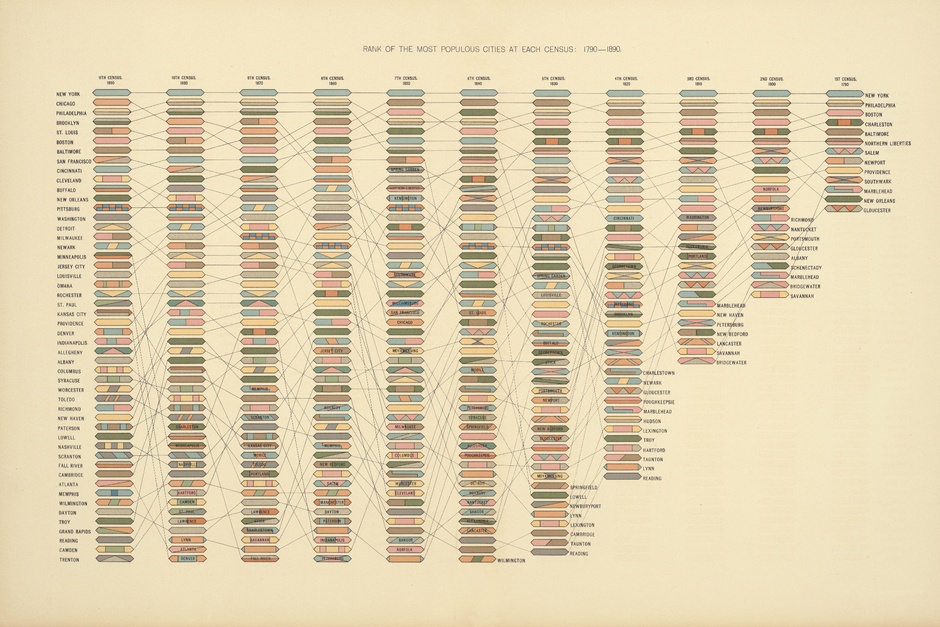I recently spent quite a lot of time looking at this 1898 infographic over at CityLab, which was making the rounds on the internet last week. Because I hail from the Northeast and spend a lot of time gawking at old architecture, it gave me a sense of completely unearned pride to see the names of now-quaint cities I know well (Portsmouth, Salem, Hudson) numbering among the most populous at the turn of the 19th century. This isn’t just a neat antiquarian curio, though. It’s a brilliant piece of data wrangling. The genius of the infographic is that it lets the numbers speak for themselves. We see American history unfold in lines and lozenges. The seaports of the late 18th century boom with the whaling and slaving industries, and then are eclipsed by the new inland industrial centers of the mid-19th century. New cities spring up further and further west thanks to the Gold Rush, homesteading, immigration, and the railroad. A century changes the population distribution of the United States into something almost unrecognizable.
I found looking at this infographic to be a little bittersweet: in my own research I can never dream of something so clear, precise, and reliable. Certainly for the period of time I work on (roughly 100 BC – 250 AD) the largest city in the Roman empire would have been Rome, much in the way New York maintains the top spot in the 1790 – 1890 US censuses (and still does today). But what was the number two city in the Roman empire when the Republic fell? Was it the same city when Hadrian ruled? Imagine writing United States history without knowing how the histories of individual cities played into the history of the whole.
It’s not that Roman historians have no data to work with. More infuriatingly, we have incomplete data. We know that there were regular censuses (ideally every 5 years) and for many years, ancient historians tell us the census figures. The problem is that no one today can agree on what exactly those numbers mean. The most hotly contested figures come from three separate censuses dating from Augustus’ reign.
28 BC: 4,036,000
8 BC: 4,233,000
14 AD: 4,937,000
A steady growth is clear. But who is being counted? Do these numbers represent only adult male citizens (those eligible to vote)? If so, the total population of the Roman empire would be substantially larger when you factor in women, children, and slaves. Or were Augustus’ agents counting every single citizen, including women and children? Different historians fall into different camps: the “high counters,” who think Augustus counted only adult male citizens, “low counters,” who think the census numbers account for most Romans (excluding slaves of course), and a newer group of “middle counters,” who think the answer lies somewhere between the two extremes.
This debate, of course, is over how many people lived in the Roman empire. The population of individual cities over time is another matter altogether. The most popular estimate for the population of Rome at its peak is about a million people, which is a wholly unverifiable number but seems plausible. Because of its plausibility, the one million number unfortunately masks the small-scale changes in population we would expect to see year to year. For other major cities of the Roman empire we have similarly scanty and static evidence. The Greek historian Diodorus Siculus tells us that the city of Alexandria in Egypt, probably the second largest city in the empire for much of Roman history, had a population of about 300,000 when it was taken by the Romans — but again, does he mean freeborn adult men or something more inclusive? What about the population five or fifteen or twenty years later?
We know that the Roman state would have had a better idea of its own population than we do. Tantalizingly, many census documents survive from Roman Egypt, which count the number of men, women, and children living in individual villages. For some villages, enough survive to do some rudimentary demographic work. But we can’t extrapolate conclusions about the whole of the empire from the profile of individual villages. For areas with climates less conducive to preserving papyrus, we can judge population growth and decline only by rather low-resolution techniques (e.g. building activity).
This uncertainty about demography stretches into almost every facet of Roman history: How many slaves were there relative to the free population? How many people knew how to read? Given the amount of food and water that the Roman government brought into Rome — which we know fairly well for some periods — how well fed and hydrated were the urban poor? What kinds of disease patterns should we look for? Barring the discovery of some anachronistically sophisticated Roman statistical analysis, we can only make educated guesses.
Further reading:
Bagnall, Roger S., and Bruce W. Frier. “The demography of Roman Egypt.” Cambridge University Press. 1994.
de Ligt, Luuk. Peasants, Citizens and Soldiers: Studies in the Demographic History of Roman Italy 225 BC-AD 100. Cambridge University Press, 2012.
Hin, Saskia. The Demography of Roman Italy: Population Dynamics in an Ancient Conquest Society 201 BCE–14 CE. Cambridge University Press, 2013.
Scheidel, Walter. Death on the Nile: disease and the demography of Roman Egypt. Brill, 2001.
Scheidel, Walter, ed. Debating Roman Demography. Brill, 2001.



